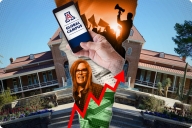You have /5 articles left.
Sign up for a free account or log in.
The National Institute for Technology in Liberal Education, in an effort to broaden its scope and address the challenges facing liberal arts colleges, will this fall launch a do-it-yourself toolkit for institutions that want to work together.
The organization, also known as NITLE, aims to use the Collaboration Consulting Program to expand its role as a consultant for liberal arts colleges. NITLE has for more than a decade helped colleges to use technology more (and more effectively) in teaching, and Michael Nanfito, the organization’s executive director, said the collaboration toolkit represents a “formalization of what we’ve done over several years.”
“Working alone doesn’t work anymore,” Nanfito said. “On a fundamental level, we see our core curriculum being challenged. The money that we used to fund that business is probably not coming back.”
Many liberal arts colleges pool their resources to tackle common challenges such as providing specialized upper-level humanities courses and developing online initiatives. After emerging from the recession only to find more layoffs and cutbacks in their future, Nanfito said, liberal arts colleges “understand that they need to collaborate, but they don’t know how.” Higher education has a tradition of cooperation -- on research projects, for example -- but not the type of “sustained, programmatic, inter-institutional collaboration” seen in other industries, he said.
According to a draft of the program, NITLE plans to work with three to five groups of colleges a year. Ideally, the consortiums will approach NITLE with a defined set of common goals, and the organization will supply a toolkit that “will guide participants through the process of developing and implementing negotiated collaboration” with practical resources on how to establish a timeline, manage budgets and promote their initiatives, among other steps. NITLE will also dispatch consultants to assist with that process, and assess outcomes during scheduled visits. As the collaborations progress, participating institutions will host webinars and post articles and case studies to NITLE’s Academic Commons.
“All of this is done in other industries and other domains,” Nanfito said. “Really, we’re just translating tools that other industries use into a language that higher ed understands.”
NITLE will therefore make the toolkit available for free on its website under a Creative Commons license, and offer additional paid consulting services for consortiums that need a little more instruction. Nanfito said the organization is in the process of finalizing the toolkit, funded by a grant from the Andrew W. Mellon Foundation, ahead of an October 8 launch during a pre-conference workshop of the Association for Collaborative Leadership’s annual conference.
Parts of the toolkit are already being used in more informal ways, Nanfito said, pointing to NITLE's work as a consultant for the Texas Language Consortium and the Virginia Foundation for Independent Colleges. The organization is engaged in exploratory talks with several other consortiums, he said.
Members of some of the groups that have previously worked with NITLE, such as the Collaborative Liberal Arts Moodle Project, or CLAMP, said they interpreted the Collaboration Consulting Program as NITLE rethinking how it can assist liberal arts colleges. When NITLE worked with CLAMP half a decade, for example, it was mainly a source of funding, said Joseph M. Murphy, director of the Center for Innovative Pedagogy at Kenyon College. Now, Murphy said, NITLE appears to be more interested in how it can impact institutional strategic priorities.
“Most tangibly, NITLE gave us the startup funds,” Murphy said. “The bluntest, easiest thing to say is that we applied for an Instructional Innovation Fund grant that gave us the money to have the meetings that allowed CLAMP to come into being.”
The grant enabled CLAMP to host workshops where developers at different colleges could meet to further tweak the open-source learning management system to benefit liberal arts institutions. But Murphy also acknowledged that had it not been for those members attending NITLE workshops in the mid-2000s, the colleges may never have decided to collaborate.
“It was the community that [NITLE] had already created of instructional technologists and faculty members who realized that there was a need for a more intense kind of collaboration on actually writing documentation, writing code and developing best practices for running a Moodle server,” Murphy said. “Without NITLE’s role in bringing people together just to start this conversation, I don’t know if we would have found one another. We certainly wouldn’t have found some of our greatest contributing members.”








